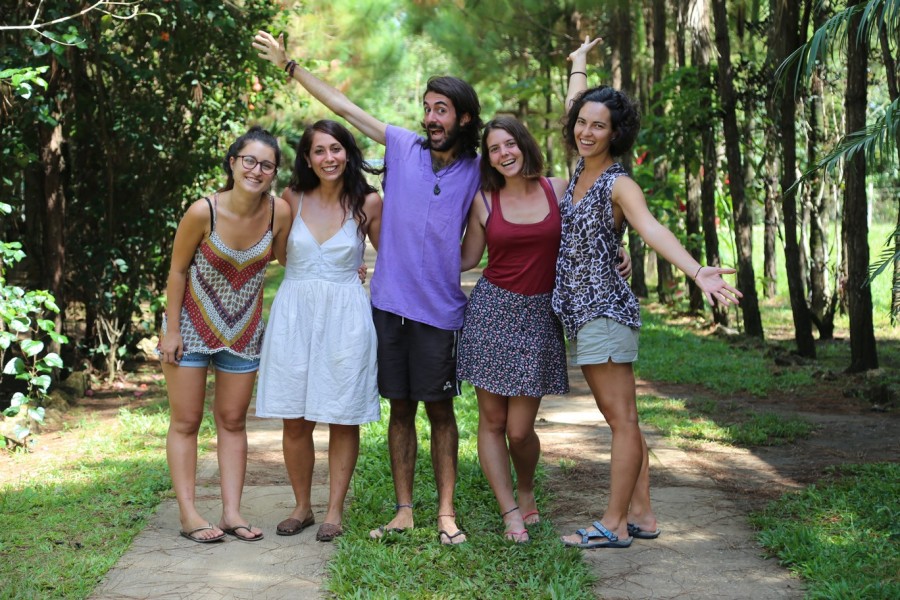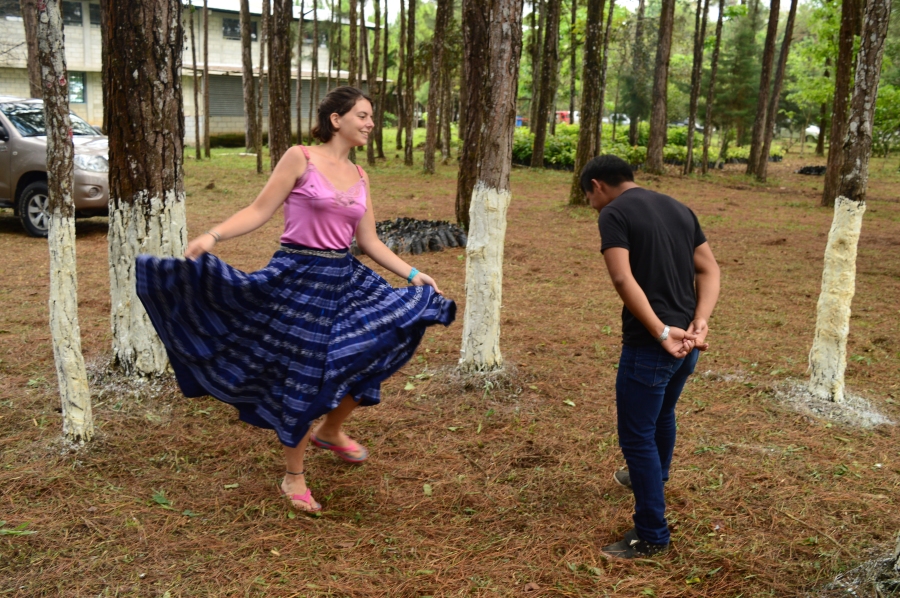I’m not going to lie: although the days we spent at the Caribbean coast and Flores were really nice, they were nothing but a holiday. We did learn a lot but what we were actually doing was getting closer and closer to our new home: Ochoch Hik’eek, “house of hope”, where we are living and working right now.
No voy a mentir: los días que pasamos en las costas caribeñas y en Flores estuvieron bien, pero no fueron más que unas vacaciones. Aunque aprendimos un montón, lo que realmente estábamos haciendo era acercarnos poco a poco a nuestra nueva casa: Ochoch Hik’eek, la Casa de la Esperanza, donde vivimos y trabajamos actualmente.

I had looked through its webpage and Facebook page a thousand times but nothing could prepare me for what the school would actually be like. When we first got to the school there were no kids there, so we had a bit of time to get to know the other volunteers (there were four of them at that time and I liked all of them loads) and some of the teachers, as well as to get acquainted with the building (and the garden and orchard!)
Había pasado horas y horas en su página web y en su facebook, pero nada podía prepararme para lo que la escuela es en realidad. Cuando llegamos por primera vez, los patojos no estaban así que tuvimos tiempo de conocer a los otros voluntarios (había cuatro y me encantaron todos) y los profesores, además de explorar un poco el terreno.



And I think this is the right time for me to talk very shortly about Guatemala in general and about this school in particular. Guatemala is a beautiful country but it has a terrible history of war and violence, against indigenous people above all. Society glorifies the Mayan past of Central America but then marginalises the grandsons of these people, who struggled to survive through the last five centuries. In spite of that, more than 20 Mayan languages are still spoken in Guatemala today.
Ahora creo que ha llegado el momento de hablar de Guatemala y de la escuela: Guatemala es un país precioso pero tiene un pasado manchado de violencia, dirigida sobre todo a las personas indígenas. La misma sociedad que glorifica a los mayas del pasado margina a sus nietos, que han estado luchando por la supervivencia durante quinientos años. A pesar de ello, en Guatemala todavía se hablan más de 20 lenguas de origen maya.

The school where we are working is a Mayan school. That means that, even if both indigenous and mixed kids are allowed to study there, there’s a subject called Mayan Cosmovision and they also study Q’eqchi’, one of the most spoken region’s languages. The founder of the school and also its principal are indigenous, which makes this school very special. However there’s something even more special about it: it’s a school for kids that live in remote villages.
Nosotros trabajamos en un Instituto Maya. Eso quiere decir que, aunque tanto indígenas como ladinos o mestizos pueden estudiar aquí, la escuela tiene una visión basada en la cosmovisión maya y asignaturas como historia o lingüística maya (ahí estudian Q’eqchí, uno de los idiomas más hablados en la región). Tanto el fundador como el director de la escuela son indígenas, cosa que saca a la escuela de lo común, pero hay algo todavía más especial: es un instituto para patojos que viven en comunidades o aldeas muy alejadas de la ciudad.



The lack of high education in rural areas is a big problem in the country, especially for kids that live in poor households where paying for transportation is not an option. Most families need their teenage kids to work alongside their parents, so when they finish primary school they just stop studying and start helping them full time. But our school works for only 15 days a month, during which there are lessons every single day from 7.30 am to 5 pm, and then the kids go back to helping their parents for the next two weeks. That system allows kids (indigenous or not, but surely poor) to get an education.
La falta de institutos en las zonas rurales es un gran problema en Guatemala, especialmente para las familias pobres que no tienen opción de pagar por transporte. La mayoría de familias necesitan que los adolescentes ayuden a sus padres en el campo, así que al terminar la primaria dejan de estudiar y se ponen a trabajar a tiempo completo. Lo diferente en nuestra escuela es que funciona 15 días al mes, durante los cuales hay clase cada día desde las siete a las cinco de la tarde, y luego los alumnos y alumnas vuelven a sus aldeas a trabajar dos semanas más. Este sistema permite que patojos pobres puedan estudiar.


And what do we do here? Well, the school can afford to pay for very few teachers (who actually go unpaid sometimes because of the lack of funding and the fact that not every student can pay every month), so we do the rest. At the moment, I am teaching them English and a beautiful subject called “Library”, Samu is teaching them Music and PE, and the other volunteers teach Arts, Productive Area (the orchard) and even Maths. We also take care of organising workshops, games and movie nights so they keep learning (and having fun) even after dinner.
¿Cuál es nuestro trabajo? Lamentablemente la escuela no puede pagar a muchos profesores (de hecho algunas veces no se paga a los profesores porque no hay dinero, ya que no todos los alumnos pueden hacer su pago todos los meses), así que nos encargamos del resto. Ahorita yo les doy inglés y también una asignatura que me encanta llamada “biblioteca”, Samu les da educación física y música y los otros voluntarios dan artes plásticas, área productiva (conocida popularmente como “el huerto”) y hasta mates. También nos encargamos de organizar talleres, juegos y noches de cine para que aprendan (y se diviertan) incluso después de cenar.


I knew most of this before ever setting foot in Guatemala, but it was still a shock to see the school, which is missing most of the resources that we think fundamental (I’m not even talking about electronic boards or hot water, I’m talking about text books and showers), to talk to the students, who come from such a different background than us. But you know what the biggest surprise was? The heaps of love I have gotten from everyone since I got here.
Antes de llegar a la escuela ya sabía gran parte de lo que os he contado, pero aun así fue sorprendente ver la escuela por primera vez y darnos cuenta de que faltan muchas cosas que considerábamos básicas (no hablo de pizarras electrónicas o agua caliente sino de libros de texto y duchas) y hablar con los estudiantes nos ayudó a comprender lo diferente que son sus vidas de las nuestras. Pero ¿saben cuál fue la mayor sorpresa de todas? Las cantidades industriales de amor que hemos recibido.



The teachers and volunteers of the school have to juggle with the lack of resources pretty much every day, but what we get in return is so big I don’t even know how to explain it. The trust of these amazing teenagers that are growing up here, sharing every single day with the rest of their mates (including us) is the most amazing reward I could get. The hugs, the talks, the confessions and the adventures they share with me and the other volunteers. This is what I could have never imagined. I knew I would love them, but not to what extent.
Los profes y voluntarios de la escuela tenemos que hacer malabares con los recursos que tenemos pero lo que recibimos a cambio es tan grande que no sé ni cómo empezar a explicarlo. La confianza de esos maravillosos adolescentes que crecen día a día, evolucionando con sus compañeros y compañeras (incluidos nosotros) es la recompensa más increíble del mundo. Los abrazos, las charlas, las confesiones y las aventuras que comparten conmigo y el resto de voluntarios no tienen precio. Eso es lo que no podía imaginar: ya sabía que los querría pero no hasta qué punto.


Preciosa entrada…. Unas fotos increibles y un texto que emociona…. Gracias chicos por dejarnos ver un trocito de allí.
LikeLiked by 2 people
¡Muchas gracias, Len! Cuando quieras aquí te esperan 🙂
LikeLike
Que bueno chicos, que maravillosa experiencia tenéis la oportunidad de vivir en ese mundo tan diferente.
Muchos besos
LikeLiked by 1 person
Very nice post. I simply stumbled upon your weblog and wanted to
say that I’ve truly enjoyed browsing your blog posts.
After all I’ll be subscribing on your feed and
I am hoping you write once more soon!
LikeLike